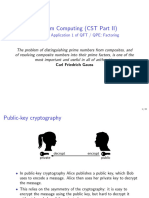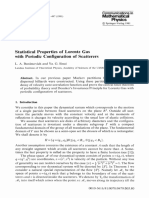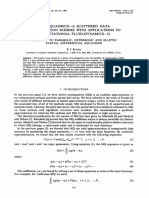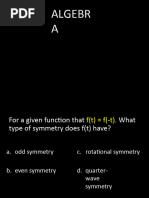Finding Zeros of A Polynomial by The Q-D Algorithm
Finding Zeros of A Polynomial by The Q-D Algorithm
Uploaded by
Emad Ali Abu HassnaienCopyright:
Available Formats
Finding Zeros of A Polynomial by The Q-D Algorithm
Finding Zeros of A Polynomial by The Q-D Algorithm
Uploaded by
Emad Ali Abu HassnaienOriginal Title
Copyright
Available Formats
Share this document
Did you find this document useful?
Is this content inappropriate?
Copyright:
Available Formats
Finding Zeros of A Polynomial by The Q-D Algorithm
Finding Zeros of A Polynomial by The Q-D Algorithm
Uploaded by
Emad Ali Abu HassnaienCopyright:
Available Formats
A. C. DOWNING, JR.
, Editor
Finding Zeros of a Polynomial mentioned furnish only one zero at a time; as soon as a
zero is found, it is divided out, and the method is started
By the Q-D Algorithm afresh with a new random start.
Other methods (such as the ones ascribed to Bernoulli
P. ~-IENRICI and Graeffe) do not require any first approximations, b u t
University of California,* Los Angeles, and Eidgenhssisehe then the convergence is usually slower and again only one
Technisehe Hochschule, Zurich, Switzerland (or two) zeros are found at a time.
I n this note we relate some experimental results cover-
BRUCE O. WATKINS
ing a technique for finding zeros based on the Quotient-
Utah State University, ~ Logan, Utah
Difference (Q-D) algorithm. This method was introduced
b y H. Rutishauser [5], and its theoretical aspects h a v e
since been discussed in a number of papers [6, 7, 8, 9]. Un-
A method which finds simultaneously all the zeros of a like any of the methods mentioned above, the Q-D al-
polynomial, developed by H. Rutishauser, has been tested on a gorithm has the advantage of furnishing simultaneous
number of polynomials with real coefficients. This slowly con- approximations to M1 zeros of a given polynomial, using
verging method (the Quotient-Difference (Q-D) algorithm) no information other t h a n the coefficients of the given
provides starting values for a Newton or a Bairstow algorithm polynomial. Theoretically the method could be used to
for more rapid convergence. determine the zeros of a polynomial with arbitrary ac-
Necessary and sufficient conditions for the existence of the curacy; however, since the method converges at least as
Q-D scheme are not completely known; however, failure may slowly as the Bernoulli method, and since it is subject to
occur when zeros have equal, or nearly equal magnitudes. propagation of rounding error, we use the Q-D method
Success was achieved, in most of the cases tried, with the only to determine first approximations to the zeros, which
failures usually traceable to the equal magnitude difficulty. then are determined more accurately b y the Newton or
In some cases, computer roundoff may result in errors which the Newton-Bairstow procedure.
spoil the scheme. Even if the Q-D algorithm does not give all T h e present paper is concerned solely with the com-
the zeros, it will usually find a majority of them. putational aspects of the algorithm. For the theory we
infer to the references given previously.
1. I n t r o d u c t i o n 2. T h e A l g o r i t h m
M a n y welLknown methods for determining the zeros Let
of a polynomial (such as the Muller method [1], Laguerre's p(z) = aoz~ + alz ~-1 + . . . -4- aN (1)
method [2], the Newton method or its variant for pairs
of complex conjugate zeros, the Bairstow method [3]) be a polynomial whose coefficients (real or complex) are
converge v e r y rapidly if good first approximations to the all different from zero. The Quotient-Difference Algorithm
zeros are known. If no such approximations are known, consists in constructing a two-dimensional array of num-
the convergence m a y be much slower or, in certain cases, bers, whose elements are arranged as indicated below ~
m a y not take place at all [4]. Furthermore, the methods in the special case N = 4 :
~o+ q~> q~ q2>
The preparation of this paper was sponsored in part by the
Office of Naval Research and the U.S. Army Research Office
(Durham). Reproduction in whole or in part is permitted for any q~'> qi: ql :> q~')
purpose of the United States Government. Part of the computing
time was supplied by the Western Data Processing Center, UCLA,
Los Angeles. Zeros were checked by a double precision program
developed by General Motors Corp., Allison Div., Indianapolis, etc.
Indiana.
* Numerical Analysis Research. 1 Our notation is adapted to the situation on hand; it does not
Department of Electrical Engineering. agree with the standard notation in [3] or [5].
570 Communications of the ACM Volume 8 / Number 9 / September, 1965
The entries in this scheme are connected b y the relations (i) For every index k such that ] zk_~ ] > ] z~ ] > ] z~+~ I,
q<k) q(k)
,+1 = + (e(,k ) - e ~ k-~)) (k = 1,2, . . . , N ) , (2) lira q~k) = zk. (7)
k~av
~(k+l)
e(k)
,~+~ = e(nk) ~n+l
(k) (k = 1 , 2 , . . . , N - - l ) , (3) Thus, if zk is the only zero of modulus I zk 1, it can be found
qn+l
as the limit of the k-th q-column. Thus in particular, if
where n = 0 , 1, 2, . . . the moduli of all zeros are distinct (which happens, for
Since each of these relations involves four adjacent instance, if all zeros are real, positive, and simple), then
entries of the scheme, they can be used to generate the the limits of all q-colunms exist and are just the zeros, in
scheme row after row as soon as the first two rows and descending order.
the first and last column of the scheme are known. The
first two rows are determined from the coefficients of the (ii) For every k such that I zk ] > I zk+a I,
polynomial, as follows: lim e~k) = 0.
k~av
q0(1) _ a~ (qgk) = 0) (lc = 2, 3, . . . , N ) , (4) Thus, if one or several e-colulnns do not converge to zero,
a0
this is an indication t h a t several zeros have the same
e0(k) _ ak+l (k = 1 , 2 , . - . , N - - l ) . (5) modulus. Most frequently this occurs when a real poly-
ak nomial has a pair of complex conjugate zeros. Such zeros,
(Here we use the assumption t h a t the coefficients of p(z) too, can be recovered from the scheme, as follows:
do not vanish.) The first and the last columns of the method (iii) For every ]c such that
consist entirely of zeros:
IZk--ll > I Z k l - ~ - I Z k + i ] ~> [ Z k + 2 l,
e~°) = e~N) = 0 (n = 0, 1, 2, . . - ) . (6) the limits
Thus for instance for the polynomial lira rtq~(k) + ~~( k + i ) 1j = Ak (8a)
n~ao
p(z) = 128z 4 -- 256z 3 + 160z~ -- 32z + 1, lim q(.~1 ~/,
- (k+l) = Bk (8b)
n --~¢¢
the first six rows of the scheme are as follows:
exist and have the values zk + zk+~ and zkzk+l , respectively;
n rows
e0 q~X) e(1) q(2) e(2) q(a) e(a) q(4) e(4) thus z 2 -- Akz + B~ is the factor of p(z) with the zeros zk
2.000000 0.000000 0.000000 0.000000 and Zk+l.
0 --0.625000 --0.200000 --0.031250 0 Relations similar to (8) also exist when there are more
1.375000 0.425000 0.168750 0.031250
0 --0.193182 --0.079412 --0.005787 0 than two zeros of equal modulus, but they are more com-
1.181818 0.538770 0.242375 0.037037 plicated [3].
0 --0.088068 --0.035725 --0,000884 0
As computational checks, two relations m a y be used:
The q k converge to the zeros of the polynomial as n in-
creases. To five significant figures the zeros for this case (1) + (2) + . . . + G ~ ) = _ a~v-1
are 0.96194, 0.69134, 0.30866, 0.03806, and are obtained ahr (9a)
with n about 15. (n = 0,1,2...)
3. Convergence Properties q(1) ^(2) q(n~)N ~- ( _ _ i ) N ao
n+1 (//n+2 """
Clearly, the method as described above m a y fail to exist, a. (9b)
since one of the divisors ~/.+i
~(k) in (3) m a y turn out to be (n= 0, 1, 2 . . - ) .
zero. Necessary and sufficient conditions for the existence
of the scheme can be given [3, 5], but they are too involved 4. E x p e r i m e n t a l Results
to be of much use in practice. Suffice it to say t h a t the As indicated above, the convergence of the Q-D scheme
method, to the extent to which it is necessary to compute is only linear and therefore slow. Furthermore, since the
it, existed in the great majority of cases which have been scheme is not self-checking, it is subject to propagation of
tried. rounding error. For these reasons it would be unwise to
If the scheme exists, it has some remarkable convergence rely solely on the Q-D scheme for the determination of
properties. We number the zeros of p in descending mag- the zeros. Following a suggestion [3], we have written a
nitude. routine which uses the scheme to produce good starting
Iz~t _>_ tz2! > . . . . >_ [z~l values for the Newton or Bairstow methods, which are
applied to the complete (undisturbed) polynomial.
and set I z0 I = ~o, I z~+1 I = 0 for convenience. The fol- I t is of interest to compare this procedure with the v e r y
lowing convergence theorems then hold. elaborate programs described in [4]. There the zeros (or
V o l u m e 8 / N u m b e r 9 / S e p t e m b e r , 1965 C o m m u n i c a t i o n s o f t h e ACIVI 571
Number
Problem Degree Coe ff~cienP Zeros or Factors 2 of Zeros
Found 3
TABLE I. POLYNOMIAL COEFFICIENTS, ZEROS AND Q-D PROGRAM ~ESIILTS
1 3 I, --i, 2, 5 --1.1325, 1.0662 2: il.8106 3
2 3 1, 0, 3, 1 --0.32219, 1.6109 ± il.7544 3
3 3* i, 1.0004, --1.0002, --1.0006 --1.00000, 1.00010, 1.00050 3
4 3* 1, 3.00006, 3.000120, 1.00006 --1.00000, --1.00001, 1.00005 3
5 3 1, 0, --3, 1 --1.8794, 1.5321, 0.34730 3
6 3* 1, 8, 21, 18 --3, --3, --2 3
7 4 128, --256, 160, --32, 1 0.96194, 0.69134, 0.30866, 0.03806 4
8 4 1, --8, 39, --62, 50 3 ±i4,12:il 4
9 4* 1, 7, 13, --3, --18 1, --2, --3, --3 4
10 4* 1, --6, 9, 4, --12 2, 2, 3, --1 4
11 4* 1, --5, 6, 4, --8 2, 2, 2, --1 4
12 4* 1, --8, 24, --32, 16 2, 2, 2, 2 4
13 4 1, --3, --14, 52, --48 4, --4.1273, 1.5637 2:i0.68002 4
14 4* 1, --3, --12, 52, --48 2, 2, 3, --4 4
15 4* 1, 3.05, 4.101, 3.10205, 1.05105 z~ z W 1.001, z W 1, z + 1.05 4
16 4 1, --3, 0, 52, --48 -3.2635, 0.95756, 2.6530 2:i2.8848 4
17 4 1, --3, --14, 0, --48 5.7098, -3.1068, 0.19852 ± il.6329 4
18 5 1, --6, 14, --16, --7, --30 3.682, - 0 . 5 ± i0.868, 1.65 2:i2.23 5
19 6 1, 0, 0, 0, 0, 1 1, - 1 , 0.33333 2: i0.86667, -0.33333 ± i0.86667 6
20 6* 1, --9, 45, 85, 34, 74, --100 --1,2,3±i4,1 ±il 6
21 6* 1, --7, 25, 25, --246, +422, --300 2, --3, 3 2: i4, 1 2: i l 6
22 6* 1, --13, 85, --305, 594, --622, 300 2, 3 , 3 2 : i 4 , 1 2 : i l 6
23 6* 1, --4, --5, 190, --666, 944, --600 2, - - 6 , 3 ± i 4 , 1 2 : i l 6
24 6* 1, --11, 65, --195, 314, --274, 100 2, 1 , 3 2 : i 4 , 1 2 : i l 6
25 7* 1, 4.870, --0.670, --0.15430003, --0.4265, --1.02113, z 2 + z + 1.01, z ~ -- z + 1.10, z ~- 1.0, z -- 1.13, 7
-- 2.48608, -- 6.2771496 z+5
26 7* 1, 507.9, --2079.899 9865.5087, --8504.8717, z ~ - 3z + 16, z 2 - z Jr 1.001, z + 1, z - - 1.1, 7
--2072.1159, 9864.8527, --9020.211 z ~ 512
27 10" 1, --2.5, --460.8, --9133.4, --50761.8, --88653.098, z ~ - 2z + 2 , z ~ + 2z-~ 2.2, z 2 + 20z + 200, z + 1, 10
-- 53510.4, -- 37313, -- 197170, -- 364800, -- 198000 z + 1.5, z + 5 , z - - 3
28 12" 1, 1288, 271787, 1337920, -1.5021189E8, 1.2664523E9, z ~ + 3z + 4, z 2 - 4z + 8, z 2 - 10z ~- 64,z-~ 1, 12
-5.2810183E9, -1.9582773E10, 9.621956E9, z + 2, z - - 16, z + 32, z + 256, z + 1024
1.9383320E10, - 3.1504466Ell, -- 8.6167780Ell,
-- 5.4975580Ell
29 13" 1, 128901, 273087, 1612424.9, -1.488606E8, z ~ + 3z-4- 4, z ~ - 4z + 8, z 2 - 10z + 64, z + 1, 13
1.1147382E9, --4.0019013E9, --2.49166E10, z A- 2, z -- 16, z -4- 32, z + 256, z + 1024,
--1.0156643E10, 2.9101496E10, --2.954675Ell, z + 1.01
- 1.1798729E12, -- 1.4200503E12, -- 5.5525336Ell
30 15" 1, 2, 334, --592, 36352, 60716, --1486310, -2191720, z z + 4z + 8, z ~ - 4z + 9, z -~ 1, z -- 2, z + 3, 15
23210431, 30731586, --169919420, --134375270, z + 4, z -- 5, z-4- 6, z-4- 7, z - b 10, z -- 11,
1.634846E9, 2.1045721E9, -5.7149106E9, z -- 12, z + 13
-- 6.2270208E9
31 18 1, 5, 10, 9, 50, 40, 30, 105, 98, 15, 81, 72, 60, 48, 36, --2.9028 2: il.8927, 0.73184 ± il.2325, 16
25, 130, 100, 520 0.50380 2: il.6390, --1.2458 2: i0.31540,
0.89442 2: i0.88178, --1.0386 2: i0.67193,
0.05192 2: i1.1350, --0.51543 2: i0.96378,
1.0210 2:i0.35144
32 19 1, 5, 10, 9, 50, 40, 30, 105, 98, 15, 81, 72, 60, 48, 36, --1.0507, --2.9028 ± il.8927, 1.0770 2: i0.32915, 15
25, 130, 100, 520, 672 --0.41890 2: il.0476, 0.50824 2: il.6396,
0.95083 2: i0.85507, 0.76888 ± il.2373,
--1.1915 ± i0.41270, 0.16098 ± i1.1971,
--0.92737 ± i0.72873
T A B L E 2. RANDOMPOLYNOMIAL COEFFICIENTS OF 5 DIGITS, ZEROS AND Q-I) PROGRAM RESULTS
1 6 53.081, --1429.7, 0.07721, --2.0143, 56.131, --561.12, 0.54839 ± i0.54964, 0.04197, --0.56935 ± i0.56935, 6
23.451 26.934
2 6 --2.9041, --6.9933, --8438.8, 23.804, --47.947, 0.15886, --0.018289, --0.068874 ± i0.15235, 6
36.539, 0.68540 --1.2054 ± i53.892
3 7 --48.773, 3.8121, --74.419, --116.96, 4.2614, --0.00035978 ± i0.020882, --0.79461 2: i2.8190, 7
--9915.8, --7.1330, --4.3250 2.2513 2: il.8147, --2.8345
(eontlnue~)
572 C o m m u n i c a t i o n s o f t h e ACM V o l u m e 8 / N u m b e r 9 / S e p t e m b e r , 1965
Numb~
Problem Degree Coe~cients I Zeros or Factors 2 ~ Zeros
Found s
4 7 3.8121, --74.419, --116.96, 4.2614, --9915.8, 0.038108 :::l:i0.066060, 0.076218, 1.7322 ~ i4.5447, 7
--0.07133, --0.04325, --4.3936 --5.1782, 21.236
5 8 1, 2.9742, --6.7676, 6.2608, --54.215, --97.167, --4.90436, 2.77582, --1.18832, --0.690732, 8
7.0080, 7.7130, --15.806 0.198214 ~ i2.37181, 0.318483 ~ i0.385059
6 8 4.3936, --8.3619, 7.7182, --5545.9, --288.08, 3803.4, 1.2106, 0.35283 ~ i0.91569, --0.98342 d:::i0.54629, 8
105.40, --54.646, 8191.9 11.420, --4.7333 ::l=i9.3942
7 8 7.7182, --5545.9, --288.08, 3803.4, 105.40, --54.646, 0.14221, 1.2085, --0.14332, 0.35080 ::t::i0.92018, 8
8191.9, 8.7029, --167.00 --0.97998 ~/0.54791, 718.60
8 9 1, --993.56, --21.125, 122.20, 2.6288, --7.7351, 0.014036 ~ i0.11897, 0.99662 ~ i0.56000, 9
7.2159, --2184.9, 61.422, --31.350 --0.0080556 A:: i1.1198, --1.0132 ::t: i0.56143,
993.58
9 9 8.7029, --167.00, 463.33, 1126.1, 76.241, --7.0508, --0.31157, 0.029598 ± i0.20480, 1.4716, 9
4085.4, -- 1036.1, -- 99.729, -- 54.649
-- --0.39604 =l::il.3425, --1.9311, 5.6018, 15.091
10 9 463.33, 1126.1, 76.241, --7.0508, --4085.4, --1036.1, 0.16456 ± i0.18925, --0.36540, 9
99.729, -- 54.649, -- 2.9041, -- 6.9933
-- --0.10821 ~ i0.25013, 0.13911,
--0.40776 ~ il.4637, --2.7533
11 15 1, 39.247, --20.573, --8.3243, 22.834, --0.78440, --0.0082883, --1.2152, 1.1806 =t::i0.53560, 15
--4.2754, 504.15, --21.134, 72.874, 2.9240, --94.501, 0.36708 ~ il.2673, --0.70578 ~ i0.96858,
5.5945, 4.0532, 2549.3, 21.129 0.022019 ± il.4604, 1.3624 =t= i0.76961,
--1.3588 ::t::i0.74633, --39.759
12 18 1, --2.6027, 693.57, --6.5842, 1.6240, --6113.5, 0.74344 ::t=/0.66073, --0.98881, 0.97248 ~ i0.24402, 12
21.652, 4.5896, --0.71410, --7.8138, 8.3005, --0.58013 ::t=i0.82796, --0.11371 ::t=i0.99865,
37.504, --64.678, 4.9990, --6.8560, 45.808, 337.62, 0.35904 ::i=i0.92990, --0.88517 ::t=i0.45229, 2.0683,
14.910, -- 6093.8
-- --1.0373 ~ il.7847, 1.3029 ± i26.304
13 36 --9265.3, 6468.0, --42.015, 70.311, 3072.4, 2.9530, 0.81276 ~ i0.061480, 0.58720 =t= i0.48197, 22
5.6163, 870.73, --7.9141, --74.110, --22.964, 9.2252, 0.22083 ± /0.700000, --0.88460 ~ /0.30152,
--2.4987, --39.063, 6.5810, --6.8461, --7.8867, 0.63308 ::t::i0.69314, --0.20948 ~ /0.89996,
--32.151, --34.637, 67.916, --390.57, 60.247, 1.0530 ± i0.087703, --0.83729 ± i0.39630,
265.74, -- 453.86, -- 7015.6, -- 309.67, -- 2.0574, --0.072582 ± /0.99088, 0.57888 ::i=i0.77201,
--85.581, --99.394, --20.775, 49.225, 3924.5, --0.583111 ~ /0.78522, 0.15853 ~ il.0003,
--0.083830, 73.941, 0.049060, 88.312, --993.56 0.82646 ± i0.57735, --0.98285 ± i0.11248,
0.39262 ~ /0.92500, 0.95385 ::t: i0.36071,
--0.74665 ::l=i0.60412, --0.37723 ~ 0.89807
* Polynomials made up from selected zeros er factors. Otherwise polynemials made u p from selected coefficients.
1 Coefficients are listed in order of descending powers of the polynomial.
Zeros and coefficients are at least six significant figures for * polynomials. Otherwise these values are to five significant figures. Factors are i ndicated in the form (z+l), etc.,
otherwise the values given are zeros.
s See discussion on equal zeros.
pairs of zeros) are found b y the N e w t o n - B a i r s t o w tech- ure to pass the test if the count was less t h a n three; other-
nique using unsophisticated first guesses, and each zero wise the count was reduced b y one on failure to pass the
(or each quadratic factor) is divided out as soon as found. test. T h e n u m b e r of iterations, n, was an i n p u t value.
As a final step, when all the zeros have been found, the Experience showed t h a t an E P S value of a b o u t 0.01 and
original polynomial is used to produce i m p r o v e d zeros an n value of a b o u t 150 gave satisfactory results for m o s t
b y iteration. I t would seem that, considered as a m e t h o d polynomials.
for finding first approximations, the Q-D scheme is m o r e Besides t r y i n g the m e t h o d on a n u m b e r of fairly simple
economical. polynomials (Table 1) a n u m b e r of other polynomials were
Several methods for checking the convergence of the investigated (Table 2). These later polynomials were m a d e
e(k)-columns in the Q-D m e t h o d were tried. T w o success- up of coefficients formed b y using r a n d o m n u m b e r s of five
ful test expressions, either of which m a y be used, follow: digits f r o m [10]. T h e decimal was placed b y spinning a
pointer with six possible stopping positions, two positions
(2 l e£~) I/(I + I + I q.-1 + [)) being used to m o v e the decimal to the right one place,
-- E P S l e~k) ]/I e(k)
25 I -- E P S . two positions being used to m o v e the decimal to the right
two places, one position three places, and one position
E P S m u s t be chosen sufficiently small so t h a t the test four places. T h e sign was established b y a coin flip. I t is
expression used will remain positive until the kth e-column of interest to note t h a t the m a g n i t u d e of m a n y of the
has effectively converged. To further ensure such con- zeros of these polynomials tend to cluster a b o u t the value
vergence, a count of five or more passages of the test set one. F o r example, in one 18th degree polynomial, 13 zeros
an indicator I(k). This count was set back to zero on fail- h a v e m a g n i t u d e s differing f r o m one b y less t h a n 1.2 per
Volume 8 / Number 9 / September, 1965 C o m m u n i c a t i o n s of the ACM 573
cent. Similar clustering was observed on most of the other showing up as slightly unequal values. A fairly simple
polynomials. program for equM real zeros of orders three and four can
Two principal difficulties were encountered in using the be devised from reference [3]. However, in actual practice,
Q-D ~lgorithm. The first consisted of obtaining a value of exactly equal zeros are highly unlikely.
zero in relation (2) due to computer roundoff. The second Another recently developed program proceeds as
consisted in the difficulty of separating roots of almost follows:
equal magnitude. Due to the clustering effect previously
discussed, the second difficulty was more serious. The (A) Q-D method (single precision) to find starting
technique used to overcome both difficulties was to make values for the zeros.
a shift of the variable along the real axis. Due to the strong (B) Newton-Bairstow method (double precision) to find
influence of coefficient variation on the zeros, as pointed more accurate values.
out by Wilkinson [4], this shift was made in double pre- (C) In (B) reduce p(z) b y dividing out the zeros Zk as
cision arithmetic. A similar shift was used in case some they are located, after a test of the remainder of the poly-
coefficient was zero. nomial evaluated at z = zk •
The technique used to obtain the results indicated in (D) Check zero count, and if count not equal to the
Table 2 was as follows: degree of polynomial, shift the variable in the reduced
polynomial on the real axis (double precision).
(A) Q-D method (single precision) to find starting (E) R e t u r n to (A) with reduced polynomial.
values for the zeros. F r o m 100 to 500 iterations were This program found all the zeros in all problems shown
used, depending on the polynomial degree. in Table 2, thus demonstrating that the difficulty in the
(B) Newton-Bairstow method (single precision) to find previously discussed program lay in the fact that the zeros
more accurate values (always using the original coeffi- were found in single precision arithmetic.
cients).
(C) Check root count, and if root count not equal to 5. C o n c l u s i o n s
the degree of the polynomial: (1) Reduce p(z) b y dividing The Q-D algorithm appears to be a useful and powerful
out the zeros that have been located. (2) Shift the variable tool in obtaining the zeros of a polynomial with real co-
in the reduced polynomial on the real axis (see [3, p. 173]). efficients since (1) all computations are with real numbers;
(D) Return to (A) with a reduced polynomial to find (2) a complete set of starting values for rapidly converging
new starting values. methods are obtained at one time, rather than one value
per iteration. The method of shifting the variable along
As can be seen from the tabular results on roots found, the real axis solves the inherent problem of separating
this method was quite successful for polynomials of ninth zeros of almost equal magnitude.
degree or lower. Shifting the variable greatly assisted in
separating zeros close in magnitude, which otherwise could RECEIVED MARCH, 1965; REVISEDJUNE, 1965
not have been located. The failures are traceable, we
believe, to the fundamental problems of finding zeros in REFERENCES
single precision arithmetic, as discussed b y Wilkinson [4]. 1. MULLER,D. A method for solving algebraic equations using
The largest magnitude zeros are produced first, and an automatic computer. Math. Tab. Wash. 10 (1956), 208--215.
thence in order of descending magnitude. Hence, by vary- 2. M,tEHLr, HAmS J. Zur iterativen auflosung algebraischer
ing the amount of the axis shift mentioned in C(2) above, gleichungen. Z. Angew. Math. und Physilc. 5 (1954), 260--263.
different zeros will be output, and if two or three different 3. HENRICI,P. Elements of Numerical Analysis. John Wiley and
shift values are used, all zeros m a y be obtained in even the Sons, New York, 1964.
most difficult cases, as the greatest computational errors 4. WIL~SON, J. H. The evaluation of the zeros of ill-condi-
occur in the later stages of the process outlined above. tioned polynomials III. Numerische Mathemematik I (1959),
150-180.
This feature might be automated, but this was not done 5. RUTISH&USER, H. Der quotienten-differenzen-algorithmus.
in this study. Z. Angew. Math. Physik. 5 (1954), 233-251.
In Table 1, zeros of exactly equal magnitude were 6. - -. Anwendungen des quotienten-differenzen-algorith-
obtained in an earlier program which did not involve the mus. Z. Angew. Math. Physik. 5 (1954), 496-507.
axis shift feature. The later program used for Table 2 7. Bestimmung der eigenvektoren und eigenwerte einer
deliberately suppressed zeros previously found, since in matrix. Z. Angew. Math. Physik. 6 (1955), 387-401.
such cases it could be assumed that the Newton process 8. Eine formel von Wronski and ihre bedautung ffir den
was incorrectly converging to a previously found zero. quotienten - differenzen - algorithmus. Z. Angew. Math.
Physik. 7 (1956), 164-165.
(This could be avoided if a reduced polynomial were used 9. HENRICI, P. The quotient-difference algorithm. Nat. Bur.
in the Newton-Bairstow scheme.) However, it was gener- Standards Applied Mathematics Series 49, U. S. Govern-
ally true that exactly equal zeros did not appear as equal ment Printing Off., Washington, D. C., 1958, 23--46.
in the results due to computer rounding. Hence, equal 10. The RAND Corp. A Million Random Digits. Free Press, Chi-
real roots, at least, will usually be found in any case, cago, 1955.
574 Communications of the ACM Volume 8 / Number 9 / September, 1965
You might also like
- NLA10Document66 pagesNLA10luisNo ratings yet
- AlgorithmDocument20 pagesAlgorithmSayantani KarmakarNo ratings yet
- Mathematical Statistics: (Communicated by Prof. H. at The Meeting of October 31, 1959)Document10 pagesMathematical Statistics: (Communicated by Prof. H. at The Meeting of October 31, 1959)d.broduskiNo ratings yet
- Proving Lower Bounds Via Pseudo-Random GeneratorsDocument14 pagesProving Lower Bounds Via Pseudo-Random GeneratorsSangat BaikNo ratings yet
- Ke Li's Lemma For Quantum Hypothesis Testing in General Von Neumann AlgebrasDocument12 pagesKe Li's Lemma For Quantum Hypothesis Testing in General Von Neumann AlgebrasEughen SvirghunNo ratings yet
- AKS Improved PDFDocument45 pagesAKS Improved PDFjames ryerNo ratings yet
- 1 s2.0 S0893965900001002 Main PDFDocument7 pages1 s2.0 S0893965900001002 Main PDFRiska Kelana PratiwiNo ratings yet
- KDV 3Document23 pagesKDV 3manoj27No ratings yet
- MLMC FounderDocument10 pagesMLMC FoundersaadonNo ratings yet
- Aula 7 - Teoria de Cordas MITDocument7 pagesAula 7 - Teoria de Cordas MITErick MouraNo ratings yet
- Factoring Algorithm Based On Parameterized Newton Method-Zhengjun Cao and Lihua LiuDocument7 pagesFactoring Algorithm Based On Parameterized Newton Method-Zhengjun Cao and Lihua LiuLuiz MattosNo ratings yet
- Davisson 1966Document3 pagesDavisson 1966kritisinha0010No ratings yet
- Application1 QFTDocument22 pagesApplication1 QFTArijit BoseNo ratings yet
- An Efficient Quantum Factoring AlgorithmDocument12 pagesAn Efficient Quantum Factoring Algorithmtimsmith1081574No ratings yet
- Quantum Particle Swarm Optimization For ElectromagneticsDocument27 pagesQuantum Particle Swarm Optimization For ElectromagneticsbababhoNo ratings yet
- 1981 Statistical Properties of Lorentz Gas with Periodic Configuration of ScatterersDocument20 pages1981 Statistical Properties of Lorentz Gas with Periodic Configuration of ScatterersshixianghuiabcNo ratings yet
- Implicit Runge-Kutta AlgorithmDocument15 pagesImplicit Runge-Kutta AlgorithmAndrés GranadosNo ratings yet
- Automatic Transfer Function Synthesis From A Bode PlotDocument6 pagesAutomatic Transfer Function Synthesis From A Bode PlotaNo ratings yet
- Quant ph06050Document9 pagesQuant ph06050Z SzNo ratings yet
- BF 01022990Document78 pagesBF 01022990Pranav ParakhNo ratings yet
- Inverse Iteration Method For Finding EigenvectorsDocument4 pagesInverse Iteration Method For Finding Eigenvectors王轩No ratings yet
- Factorization Reduced To Order FindingDocument4 pagesFactorization Reduced To Order FindingavnishNo ratings yet
- An Implicitly Restarted Block Arnoldi Method in A Vector-Wise FashionDocument10 pagesAn Implicitly Restarted Block Arnoldi Method in A Vector-Wise FashionHabita KadourNo ratings yet
- Integer Multiples of Periodic Continued FractionsDocument14 pagesInteger Multiples of Periodic Continued FractionsDenis JaissonNo ratings yet
- Institute For Theoretical Physics, University o F UtrechtDocument25 pagesInstitute For Theoretical Physics, University o F UtrechtSantiago Ballesteros BarreraNo ratings yet
- HPL Brims 96 04Document18 pagesHPL Brims 96 04jeannotkabNo ratings yet
- The Ten Martini ProblemDocument42 pagesThe Ten Martini ProblemΧάρης ΦραντζικινάκηςNo ratings yet
- Solving Structured Linear Systems With Large Displacement RankDocument27 pagesSolving Structured Linear Systems With Large Displacement RankshllgtcaNo ratings yet
- 1 s2.0 089812219090271K MainDocument15 pages1 s2.0 089812219090271K Mainsatyakali24No ratings yet
- On The Irrationality of ZDocument7 pagesOn The Irrationality of ZMeriam LondonNo ratings yet
- On the Spectral Representation Method in SimulationDocument16 pagesOn the Spectral Representation Method in SimulationsumaijiaNo ratings yet
- FEM Lagrangian MultipliersDocument14 pagesFEM Lagrangian MultipliersVan Dung NguyenNo ratings yet
- Abstract.: BIT I9 11979), 35ff 367Document12 pagesAbstract.: BIT I9 11979), 35ff 367MárcioBarbozaNo ratings yet
- On The Markov Chain Monte Carlo (MCMC) Method: Rajeeva L KarandikarDocument24 pagesOn The Markov Chain Monte Carlo (MCMC) Method: Rajeeva L KarandikarDiana DilipNo ratings yet
- 2210.03224v3Document42 pages2210.03224v3José MartínezNo ratings yet
- A Fast Algorithm For Computing Pseudospectra of Companion MatricesDocument4 pagesA Fast Algorithm For Computing Pseudospectra of Companion MatricesInternational Journal of Science and Engineering InvestigationsNo ratings yet
- Convergence Rates of Best N-Term Galerkin ApproximDocument29 pagesConvergence Rates of Best N-Term Galerkin ApproximThiago NobreNo ratings yet
- Implicit Runge-KuttaDocument9 pagesImplicit Runge-KuttaAndrés GranadosNo ratings yet
- Courant Number PDFDocument14 pagesCourant Number PDFUday JoshiNo ratings yet
- Efficient Quantum Tomography IIDocument35 pagesEfficient Quantum Tomography IIYashNo ratings yet
- The Infinite Hidden Markov ModelDocument8 pagesThe Infinite Hidden Markov Modelwei fengNo ratings yet
- Two-Body Problem With DragDocument13 pagesTwo-Body Problem With DragMaria RitaNo ratings yet
- Two-Qubit Quantum Computing With Pulsed NMRDocument5 pagesTwo-Qubit Quantum Computing With Pulsed NMRJuan Bernardo Delgadillo GallardoNo ratings yet
- Linear Algebra of Quantum Mechanics and The Simulation of A Quantum ComputerDocument9 pagesLinear Algebra of Quantum Mechanics and The Simulation of A Quantum Computeraniruddhamishra26No ratings yet
- Modal Coupling in One Dimensional Anharmonic LatticesDocument5 pagesModal Coupling in One Dimensional Anharmonic LatticesMomentod'InerziaNo ratings yet
- Circulant MatricesDocument20 pagesCirculant MatricesAbeer ZahidNo ratings yet
- 1709 00248Document30 pages1709 00248AliNo ratings yet
- The Toilet Paper ProblemDocument7 pagesThe Toilet Paper ProblemMamoun El KhettarNo ratings yet
- A New Generalized Learning Vector Quantization AlgorithmDocument6 pagesA New Generalized Learning Vector Quantization AlgorithmapramunendarNo ratings yet
- 1 s2.0 S0898122100003400 MainDocument14 pages1 s2.0 S0898122100003400 Mainwaciy70505No ratings yet
- QM Graphic DynamicsDocument26 pagesQM Graphic Dynamicsunima3610No ratings yet
- Lecture08 1Document3 pagesLecture08 1lgiansantiNo ratings yet
- Generalizing and Derandomizing Gurvits's Approximation Algorithm For The PermanentDocument19 pagesGeneralizing and Derandomizing Gurvits's Approximation Algorithm For The Permanentwalter huNo ratings yet
- Global Iterative Solution Dielectric Spectroscopv Equations: Sylvie Remi VaillancourtDocument6 pagesGlobal Iterative Solution Dielectric Spectroscopv Equations: Sylvie Remi VaillancourtVia GshNo ratings yet
- 1984, Aziz, Muhammad, Zero-Free-Regions-For-Polynomials-And-Some-Generalizations-Of-Enestrom-Kakeya-TheoremDocument8 pages1984, Aziz, Muhammad, Zero-Free-Regions-For-Polynomials-And-Some-Generalizations-Of-Enestrom-Kakeya-Theoremshafiyanazir2No ratings yet
- CC Many Small BodiesDocument12 pagesCC Many Small BodiesAtique KhanNo ratings yet
- LectureNotes0U MergedDocument97 pagesLectureNotes0U MergedfophirfNo ratings yet
- Markov Chains ErgodicityDocument8 pagesMarkov Chains ErgodicitypiotrpieniazekNo ratings yet
- Jens Zemke - Abstract Perturbed Krylov MethodsDocument29 pagesJens Zemke - Abstract Perturbed Krylov MethodsJulio Cesar Barraza BernaolaNo ratings yet
- Green's Function Estimates for Lattice Schrödinger Operators and ApplicationsFrom EverandGreen's Function Estimates for Lattice Schrödinger Operators and ApplicationsNo ratings yet
- Sine Wave Oscillators: Op Amps For EveryoneDocument24 pagesSine Wave Oscillators: Op Amps For EveryoneEmad Ali Abu HassnaienNo ratings yet
- Silicon Bridge Rectifiers KBP2005 - KBP210Document3 pagesSilicon Bridge Rectifiers KBP2005 - KBP210Emad Ali Abu HassnaienNo ratings yet
- Vishay Roederstein: (Code Pos. 9 2)Document4 pagesVishay Roederstein: (Code Pos. 9 2)Emad Ali Abu HassnaienNo ratings yet
- Unisonic Technologies Co., LTD: 4A, 600V N-Channel Power MosfetDocument9 pagesUnisonic Technologies Co., LTD: 4A, 600V N-Channel Power MosfetEmerson FerreiraNo ratings yet
- Ew PDFDocument1 pageEw PDFEmad Ali Abu HassnaienNo ratings yet
- 1 PDFDocument2 pages1 PDFEmad Ali Abu HassnaienNo ratings yet
- Vishay Roederstein: (Code Pos. 9 2)Document4 pagesVishay Roederstein: (Code Pos. 9 2)Emad Ali Abu HassnaienNo ratings yet
- PDF9078750-PDFThe Worlds Writing SystemsDocument2 pagesPDF9078750-PDFThe Worlds Writing SystemsEmad Ali Abu Hassnaien0% (1)
- Cataloge PDFDocument55 pagesCataloge PDFEmad Ali Abu HassnaienNo ratings yet
- Mathematics 1Document26 pagesMathematics 1T Brenda VillapandoNo ratings yet
- Review On AlgebraDocument29 pagesReview On AlgebraGraziela GutierrezNo ratings yet
- 5.1 Adding and Subtracting PolynomialsDocument3 pages5.1 Adding and Subtracting PolynomialsJohannah AlinorNo ratings yet
- Enhanced Mathematics Q2 LAS Week 3Document8 pagesEnhanced Mathematics Q2 LAS Week 3RutchelNo ratings yet
- Module 3 - Polynomial Functions PDFDocument26 pagesModule 3 - Polynomial Functions PDFanamarietuvNo ratings yet
- Department of Education: Mathematics 7 Quarter 1 Learning Competencies Analysis On 4Cs of 21St Century SkillsDocument22 pagesDepartment of Education: Mathematics 7 Quarter 1 Learning Competencies Analysis On 4Cs of 21St Century SkillsJerome ManabatNo ratings yet
- DS Lab Handout - 2023Document18 pagesDS Lab Handout - 2023sanujNo ratings yet
- Yellow Book 2021Document2,082 pagesYellow Book 2021jessysosexy12100% (1)
- Lec 4 FunctionsDocument21 pagesLec 4 Functionszainkashif628No ratings yet
- Chapter 2 Maths Cbse 10 AnswerDocument24 pagesChapter 2 Maths Cbse 10 AnswerRamyaNo ratings yet
- COLLEGE AND ADVANCE ALGEBRA Chapter 4Document31 pagesCOLLEGE AND ADVANCE ALGEBRA Chapter 4Myla VelascoNo ratings yet
- Ut 01Document116 pagesUt 01obitobiuchiha15No ratings yet
- MHF4U1 Lesson 1.1 SolutionsDocument7 pagesMHF4U1 Lesson 1.1 SolutionsClumley ClungNo ratings yet
- Numerical Chapter-4Document22 pagesNumerical Chapter-4wondosen.lNo ratings yet
- Numerical Polynomial AlgebraDocument487 pagesNumerical Polynomial AlgebraLê Nhật Thăng100% (1)
- Caie As Level Further Maths 9231 Further Pure 1 v1Document17 pagesCaie As Level Further Maths 9231 Further Pure 1 v1poggderNo ratings yet
- IOQM Sprint L5 - Quadratic EquationsDocument37 pagesIOQM Sprint L5 - Quadratic EquationsSoumya SoniNo ratings yet
- Functions TN F-1 PDFDocument20 pagesFunctions TN F-1 PDFSarika100% (1)
- Portfolio in College and Advanced AlgebraDocument11 pagesPortfolio in College and Advanced AlgebraSean Wesley delos ReyesNo ratings yet
- 9finding Asymptotes KeyDocument6 pages9finding Asymptotes KeyKrishna100% (1)
- Chapter 7 Further AlgebraDocument19 pagesChapter 7 Further Algebrakotak.pskblinjamsosNo ratings yet
- Lesson Plan in Grade 7 Mathematics 7 - Algebra IntroductionDocument8 pagesLesson Plan in Grade 7 Mathematics 7 - Algebra IntroductionChuck Lyn AlianzaNo ratings yet
- Numeric MethodDocument66 pagesNumeric MethodashokNo ratings yet
- Representation of Curves and SurfacesDocument36 pagesRepresentation of Curves and SurfacesShahmirBalochNo ratings yet
- Yr10 5.3 PolynomialsDocument10 pagesYr10 5.3 Polynomialsmohamad.elali01No ratings yet
- Solution:: Chapter 8 - Division of Algebraic ExpressionsDocument9 pagesSolution:: Chapter 8 - Division of Algebraic ExpressionsSATAMANYU BHOLNo ratings yet
- Quarter 2-Module-2-Graph-of-Polynomial-FunctionDocument22 pagesQuarter 2-Module-2-Graph-of-Polynomial-FunctionDianne Dynah Bilaro DyNo ratings yet
- CBSE Class 10 Maths Chapter 2 Polynomials Revision NotesDocument74 pagesCBSE Class 10 Maths Chapter 2 Polynomials Revision NotesitilimitedmspezNo ratings yet
- SMTH Algebra 2 AAC Public OverviewDocument16 pagesSMTH Algebra 2 AAC Public OverviewrvmacroNo ratings yet
- Polynomials Ix 23-24 - QPDocument6 pagesPolynomials Ix 23-24 - QPShubCrunchtimeNo ratings yet

































































































